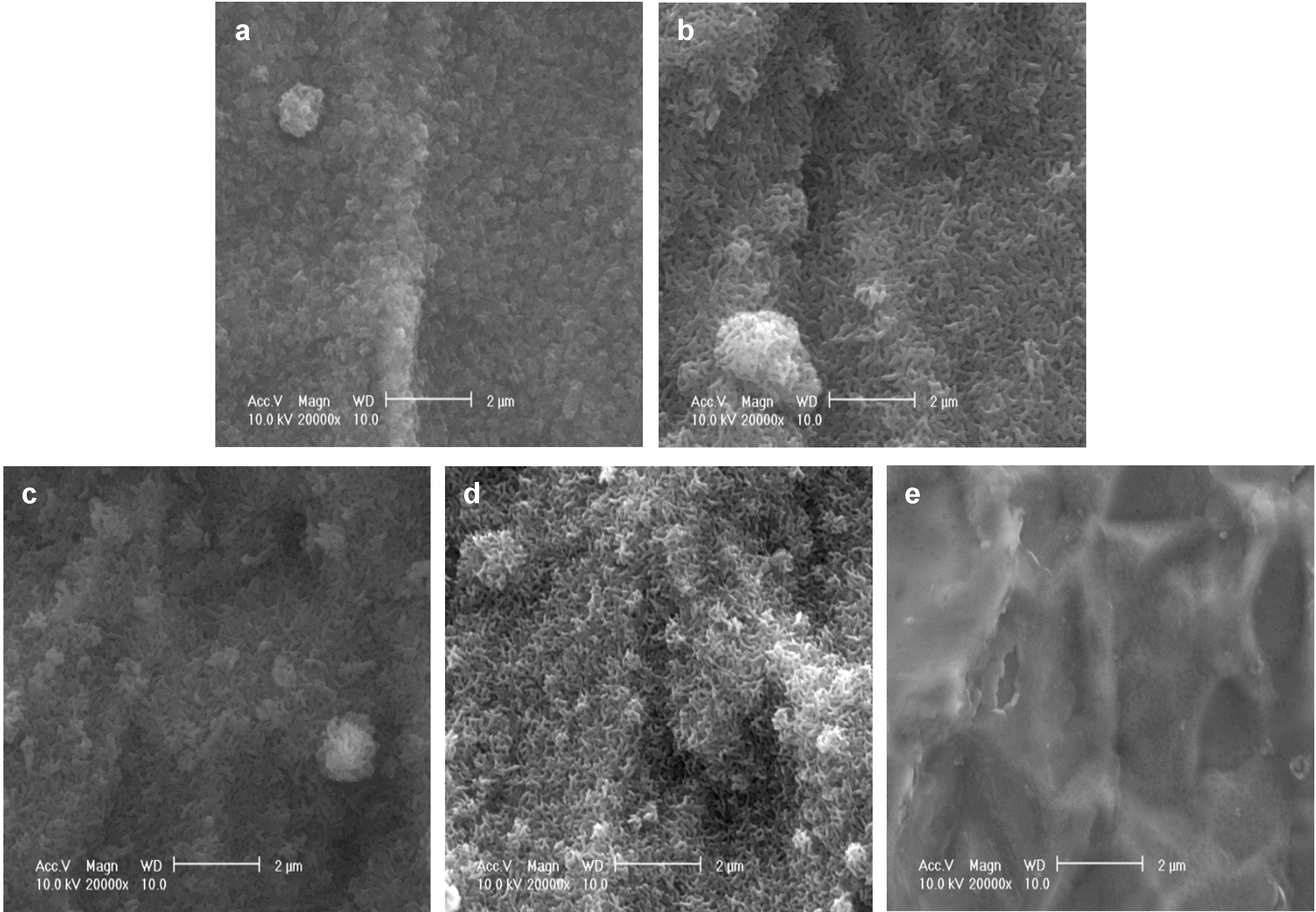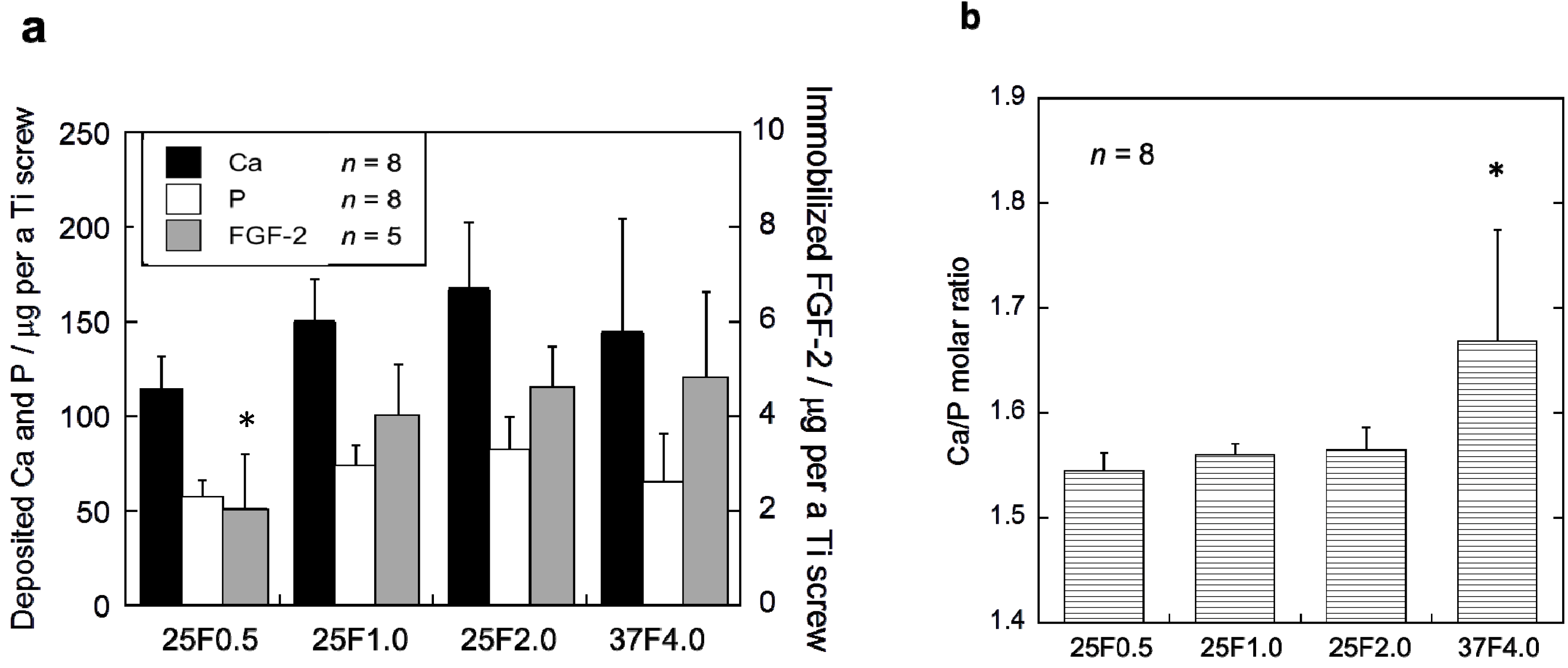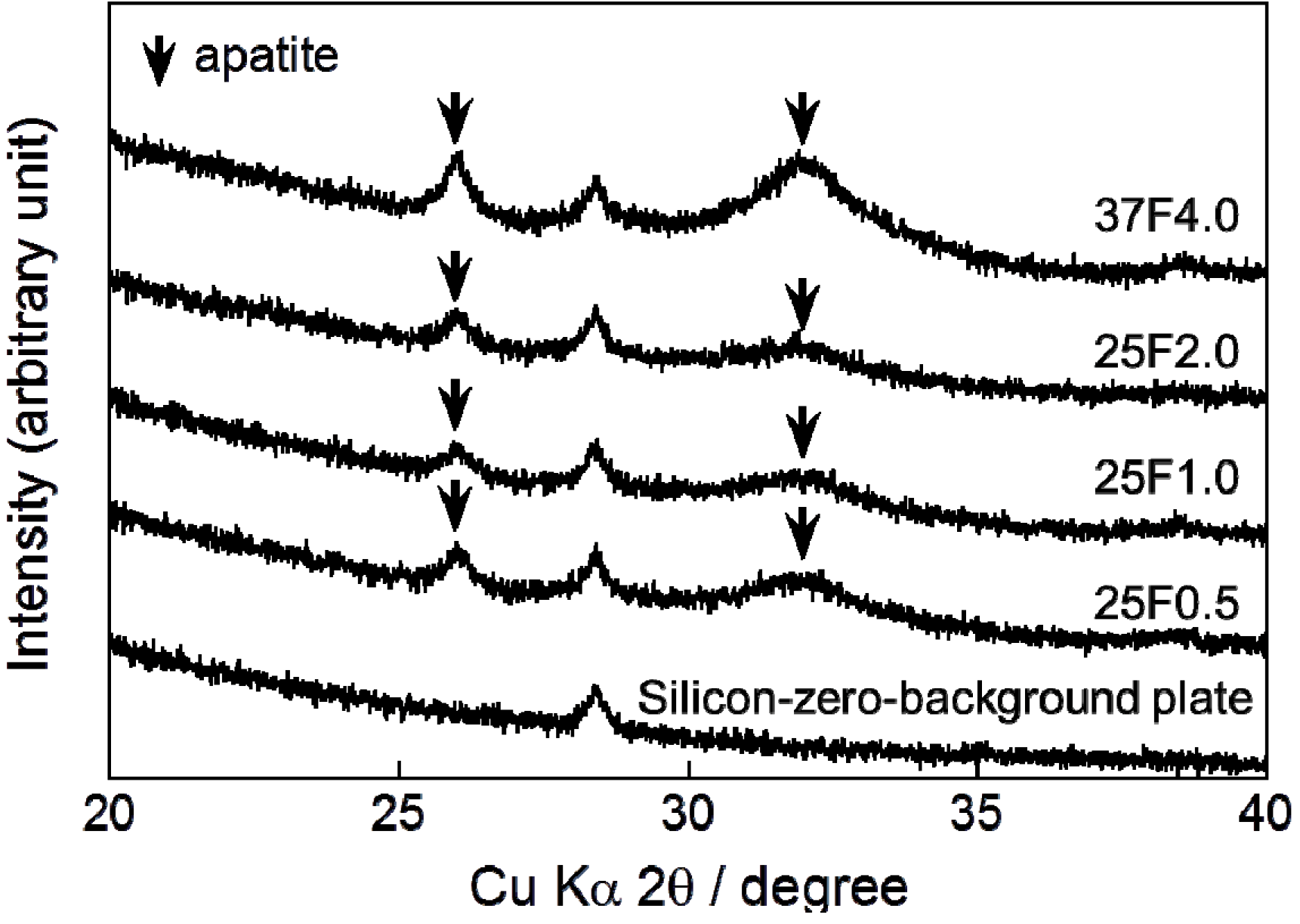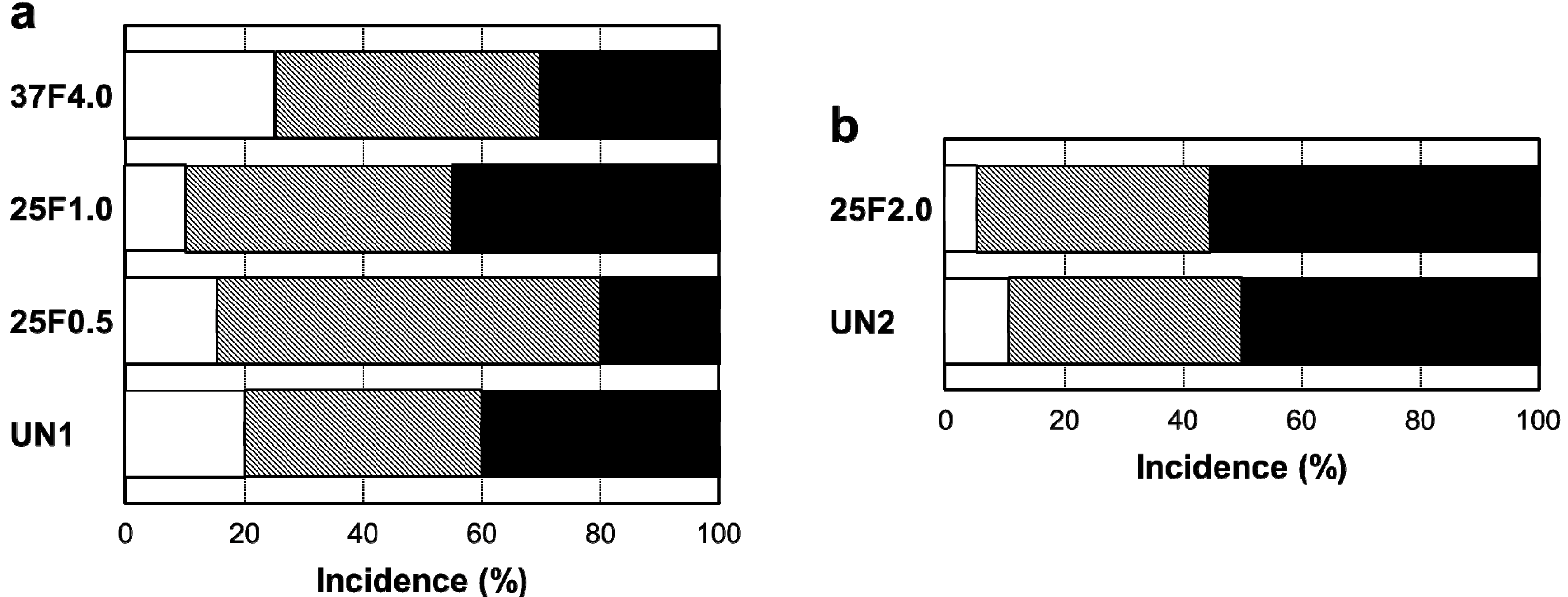The Calcium Phosphate Matrix of FGF-2-Apatite Composite Layers Contributes to Their Biological Effects
Abstract
:1. Introduction
2. Results and Disscussion
2.1. Characterization of the FGF-2-Apatite Composite Layers





2.2. Classification of Pin Tract Infections by Visual Inspection

 : Grade 0v,
: Grade 0v,  : Grade 1v,
: Grade 1v,  : Grade 2v. * p < 0.05.
: Grade 2v. * p < 0.05.
 : Grade 0v,
: Grade 0v,  : Grade 1v,
: Grade 1v,  : Grade 2v. * p < 0.05.
: Grade 2v. * p < 0.05. 
2.3. Classification of Inflammation Grade by Histological Observation

 : Grade 0s,
: Grade 0s,  : Grade 1s,
: Grade 1s,  : Grade 2s.
: Grade 2s.
 : Grade 0s,
: Grade 0s,  : Grade 1s,
: Grade 1s,  : Grade 2s.
: Grade 2s.

 : Grade 0b,
: Grade 0b,  : Grade 1b,
: Grade 1b,  : Grade 2b. * p < 0.05.
: Grade 2b. * p < 0.05.
 : Grade 0b,
: Grade 0b,  : Grade 1b,
: Grade 1b,  : Grade 2b. * p < 0.05.
: Grade 2b. * p < 0.05.

2.4. Bacterial Identification in Pin Tracts
 : No bacteria,
: No bacteria,  : E. coli,
: E. coli,  : S. aureus. * p < 0.05.
: S. aureus. * p < 0.05.
 : No bacteria,
: No bacteria,  : E. coli,
: E. coli,  : S. aureus. * p < 0.05.
: S. aureus. * p < 0.05.
2.5. Extraction Torque

2.6. Discussion
3. Experimental Section
3.1. Preparation of Supersaturated CaP Solutions
| Components | Immersion Solution (25F0.5, 25F1.0, and 25F2.0) | Immersion Solution (37F4.0) |
|---|---|---|
| mM | mM | |
| Na+ | 147.23 | 138.87 |
| K+ | 9.92 | 7.39 |
| Ca2+ | 8.92 | 3.67 |
| Mg2+ | 0.24 | 0.22 |
| Cl− | 153.46 | 134.39 |
| H2PO4− | 0.95 | 0.90 |
| HPO42− | 2.02 | 0.94 |
| HCO3− | 15.09 | 15.09 |
| CH3COO− | 1.9 | 1.80 |
| xylitol | 31.65 | 29.93 |
3.2. Immersion of Ti Pins in the Supersaturated Solution
3.3. Characterization of the Composite Layers
3.4. Animal Experiments
3.5. Classification of Pin Tract Infections by Visual Inspection
3.6. Histological Analysis
3.7. Bacterial Culture and Identification
3.8. Biomechanical Analysis
3.9. Statistical Analyses
4. Conclusions
Acknowledgments
Author Contributions
Conflicts of Interest
References
- Mahan, J.; Seligson, D.; Henry, S.L.; Hynes, P.; Dobbins, J. Factors in pin tract infections. Orthopedics 1991, 14, 305–308. [Google Scholar]
- Sims, M.; Saleh, M. External fixation—The incidence of pin site infection: Aprospective audit. J. Orthop. Nurs. 2000, 4, 59–63. [Google Scholar]
- Parameswaran, A.D.; Roberts, C.S.; Seligson, D.; Voor, M. Pin tract infection with contemporary external fixation: How much of a problem? J. Orthop. Trauma 2003, 17, 503–507. [Google Scholar] [CrossRef]
- Rafique, A.; Ghani, S.; Sadiq, M.; Siddiqui, I.A. Kirschner wire pin tract infection rates between percutaneous and buried wires in treating metacarpal and phalangeal fractures. J. Coll. Phys. Surg. Pakistan 2006, 16, 518–520. [Google Scholar]
- Zlowodzki, M.; Prakash, J.S.; Aggerwal, N.K. External fixation of complex femoral shaft fracture. Int. Orthop. 2007, 31, 409–413. [Google Scholar] [CrossRef]
- W-Dahl, A.; Toksvig-Larsen, S. No clinical benefits using a new design of pins for external fixation: A randomized study in 50 patients operated on by the hemicallotasis technique. Arch. Orthop. Trauma Surg. 2008, 128, 661–667. [Google Scholar] [CrossRef]
- Schalamon, J.; Petnehazy, T.; Ainoedhofer, H.; Zwick, E.B.; Singer, G.; Hoellwarth, M.E. Pin tract infection with external fixation of pediatric fractures. J. Pediatr. Surg. 2007, 42, 1584–1587. [Google Scholar] [CrossRef]
- Lethaby, A.; Temple, J.; Santy, J. Pin site care for preventing infections associated with external bone fixators and pins. Cochrane Database Syst. Rev. 2008, 8. [Google Scholar] [CrossRef]
- Moroni, A.; Aspenberg, P.; Toksvig-Larsen, S.; Falzarano, G.; Giannini, S. Enhanced fixation with hydroxyapatite coated pins. Clin. Orthop. Relat. Res. 1998, 346, 171–177. [Google Scholar]
- Moroni, A.; Heikkila, J.; Magyar, G.; Toksvig-Larsen, S.; Giannini, S. Fixation strength and pin tract infection of hydroxyapatite-coated tapered pins. Clin. Orthop. Relat. Res. 2001, 388, 209–217. [Google Scholar] [CrossRef]
- Shirai, T.; Tsuchiya, H.; Shimizu, T.; Ohtani, K.; Zen., Y.; Tomita, K. Prevention of pin tract infection with titanium-copper alloys. J. Biomed. Mater. Res. B 2009, 91, 373–380. [Google Scholar]
- Massè, A.; Bruno, A.; Bosetti, M.; Biasibetti, A.; Cannas, M.; Gallinaro, P. Prevention of pin track infection in external fixation with silver coated pins: Clinical and microbiological results. J. Biomed. Mater. Res. 2000, 53, 600–604. [Google Scholar] [CrossRef]
- Coester, L.M.; Nepola, J.V.; Allen, J.; Marsh, J.L. The effects of silver coated external fixation pins. Iowa Orthop. J. 2006, 26, 48–53. [Google Scholar]
- Oka, Y.; Kim, W.C.; Yoshida, T.; Hirashima, T.; Mouri, H.; Urade, H.; Itoh, Y.; Kubo, T. Efficacy of titanium dioxide photocatalyst for inhibition of bacterial colonization on percutaneous implants. J. Biomed. Mater. Res. B 2008, 86, 530–540. [Google Scholar]
- DeJong, E.S.; DeBerardino, T.M.; Brooks, D.E.; Nelson, B.J.; Campbell, A.A.; Bottoni, C.R.; Pusateri, A.E.; Walton, R.S.; Guymon, C.H.; McManus, A.T. Antimicrobial efficacy of external fixator pins coated with a lipid stabilized hydroxyapatite/chlorhexidine complex to prevent pin tract infection in a goat model. J. Trauma 2001, 50, 1008–1014. [Google Scholar] [CrossRef]
- Forster, H.; Marotta, J.S.; Heseltine, K.; Milner, R.; Jani, S. Bactericidal activity of antimicrobial coated polyurethane sleeves for external fixation pins. J. Orthop. Res. 2004, 22, 671–677. [Google Scholar] [CrossRef]
- Mutsuzaki, H.; Ito, A.; Sakane, M.; Sogo, Y.; Oyane, A.; Ochiai, N. FGF-2-apatite composite layers on titanium screws to reduce pin tract infection rate. J. Biomed. Mater. Res. B 2008, 86, 365–374. [Google Scholar]
- Liu, Y.; Cai, S.; Shu, X.Z.; Shelby, J.; Prestwich, G.D. Release of basic fibroblast growth factor from a crosslinked glycosaminoglycan hydrogel promotes wound healing. Wound Repair Regen. 2007, 15, 245–251. [Google Scholar] [CrossRef]
- Wang, J.S.; Aspenberg, P. Basic fibroblast growth factor promotes bone ingrowth in porous hydroxyapatite. Clin. Orthop. Relat. Res. 1996, 333, 252–260. [Google Scholar]
- Sakakibara, Y.; Tambara, K.; Sakaguchi, G.; Lu, F.; Yamamoto, M.; Nishimura, K.; Tabata, Y.; Komeda, M. Toward surgical angiogenesis usin37F4.0low-released basic fibroblast growth factor. Eur. J. Cardiothorac. Surg. 2003, 24, 105–111. [Google Scholar] [CrossRef]
- Mutsuzaki, H.; Ito, A.; Sogo, Y.; Sakane, M.; Oyane, A.; Ochiai, N. Enhanced wound healing associated with Sharpey’s fiber-like tissue formation around FGF-2-apatite composite layers on percutaneous titanium screws in rabbits. Arch. Orthop. Trauma Surg. 2012, 132, 113–121. [Google Scholar] [CrossRef]
- Chen, G.; Gulbranson, D.R.; Yu, P.; Hou, Z.; Thomson, J.A. Thermal stability of fibroblast growth factor protein is a determinant factor in regulating self-renewal, differentiation, and reprogramming in human pluripotent stem cells. Stem Cells 2012, 30, 623–630. [Google Scholar] [CrossRef]
- Li, X.; Wang, X.P.; Ito, A.; Sogo, Y.; Cheng, K.; Oyane, A.; Yamazaki, A. Effect of coprecipitation temperature on the properties and activity of fibroblast growth factor-2 apatite composite layer. Mater. Sci. Eng. C 2009, 29, 216–221. [Google Scholar] [CrossRef]
- Mutsuzaki, H.; Sogo, Y.; Oyane, A.; Ito, A. Improved bonding of partially osteomyelitic bone to titanium pins owing to biomimetic coating of apatite. Int. J. Mol. Sci. 2013, 14, 24366–24379. [Google Scholar] [CrossRef]
- Oyane, A.; Ootsuka, T.; Hayama, K.; Sogo, Y.; Ito, A. Enhanced immobilization of acidic proteins in the apatite layer via electrostatic interactions in a supersaturated calcium phosphate solution. Acta Biomater. 2011, 7, 2969–2976. [Google Scholar] [CrossRef]
- Harding, I.S.; Rashid, N.; Hing, K.A. Surface charge and the effect of excess calcium ions on the hydroxyapatite surface. Biomaterials 2005, 26, 6818–6826. [Google Scholar] [CrossRef]
- Rohanizadeh, R.; Padrines, M.; Bouler, J.M.; Couchourel, D.; Fortun, Y.; Daculsi, G. Apatite precipitation after incubation of biphasic calcium-phosphate ceramic in various solutions: Influence of seed species and proteins. J. Biomed. Mater. Res. 1998, 42, 530–539. [Google Scholar] [CrossRef]
- Onuma, K.; Kanzaki, N.; Kobayashj, N. Association of calcium phosphate and fibroblast growth factor-2: A dynamic light scattering study. Macromol. Biosci. 2004, 4, 39–46. [Google Scholar] [CrossRef]
- Tsurushima, H.; Marushima, A.; Suzuki, K.; Oyane, A.; Sogo, Y.; Nakamura, K; Matsumura, A.; Ito, A. Enhanced bone formation using hydroxyapatite ceramic coated with fibroblast growth factor-2. Acta Biomater. 2010, 6, 2751–2759. [Google Scholar] [CrossRef]
- Zhu, H.; Duchesne, L.; Rudland, P.S.; Fernig, D.G. Therc heparan sulfate co-receptor and the concentration of fibroblast growth factor-2 independently elicit different signalling patterns from the fibroblast growth factor receptor. Cell. Commun. Signal. 2010, 8. [Google Scholar] [CrossRef]
- Liu, Y.L.; Layrolle, P.; de Bruijn, J.; van Blitterswijk, C.; de Groot, K. Biomimetic coprecipitation of calcium phosphate and bovine serum albumin on titanium alloy. J. Biomed. Mater. Res. 2001, 57, 327–335. [Google Scholar] [CrossRef]
- Uchida, M.; Oyane, A.; Kim, H.M.; Kokubo, T.; Ito, A. Biomimetic coating of laminin-apatite composite on titanium metal and its excellent cell-adhesive properties. Adv. Mater. 2004, 16, 1071–1074. [Google Scholar] [CrossRef]
- Sogo, Y.; Ito, A.; Fukasawa, K.; Kondo, N.; Ishikawa, Y.; Ichinose, N.; Ymazaki, A. Coprecipitation of cytochrome C with calcium phosphate on hydroxyapatite ceramic. Curr. Appl. Phys. 2005, 5, 526–530. [Google Scholar] [CrossRef]
- Liu, Y.; de Groot, K.; Hunziker, E.B. BMP-2 liberated from biomimetic implant coatings induces and sustains direct ossification in an ectopic rat model. Bone 2005, 36, 745–757. [Google Scholar] [CrossRef]
- Dey, A.; Bomans, P.H.; Müller, F.A.; Will, J.; Frederik, P.M.; de With, G.; Sommerdijk, N.A. The role of prenucleation clusters in surface-induced calcium phosphate crystallization. Nat. Mater. 2010, 9, 1010–1014. [Google Scholar] [CrossRef]
- Onuma, K.; Ito, A. Cluster growth model for hydroxyapatite. Chem. Mater. 1998, 10, 3346–3351. [Google Scholar] [CrossRef]
- Wang, L.; Nancollas, G.H. Calcium orthophosphates: Crystallization and dissolution. Chem. Rev. 2008, 108, 4628–4669. [Google Scholar] [CrossRef]
- Kim, H.M.; Miyaji, F.; Kokubo, T.; Nakamura, T. Effect of heat treatment on apatite-forming ability of Ti metal induced by alkali treatment. J. Mater. Sci. Mater. Med. 1997, 8, 341–347. [Google Scholar] [CrossRef]
- Guide for the care and use of laboratory animals. Available online: http://grants.nih.gov/grants/olaw/ (accessed on 5 June 2014).
© 2014 by the authors; licensee MDPI, Basel, Switzerland. This article is an open access article distributed under the terms and conditions of the Creative Commons Attribution license (http://creativecommons.org/licenses/by/3.0/).
Share and Cite
Mutsuzaki, H.; Ito, A.; Sogo, Y.; Sakane, M.; Oyane, A.; Yamazaki, M. The Calcium Phosphate Matrix of FGF-2-Apatite Composite Layers Contributes to Their Biological Effects. Int. J. Mol. Sci. 2014, 15, 10252-10270. https://doi.org/10.3390/ijms150610252
Mutsuzaki H, Ito A, Sogo Y, Sakane M, Oyane A, Yamazaki M. The Calcium Phosphate Matrix of FGF-2-Apatite Composite Layers Contributes to Their Biological Effects. International Journal of Molecular Sciences. 2014; 15(6):10252-10270. https://doi.org/10.3390/ijms150610252
Chicago/Turabian StyleMutsuzaki, Hirotaka, Atsuo Ito, Yu Sogo, Masataka Sakane, Ayako Oyane, and Masashi Yamazaki. 2014. "The Calcium Phosphate Matrix of FGF-2-Apatite Composite Layers Contributes to Their Biological Effects" International Journal of Molecular Sciences 15, no. 6: 10252-10270. https://doi.org/10.3390/ijms150610252
APA StyleMutsuzaki, H., Ito, A., Sogo, Y., Sakane, M., Oyane, A., & Yamazaki, M. (2014). The Calcium Phosphate Matrix of FGF-2-Apatite Composite Layers Contributes to Their Biological Effects. International Journal of Molecular Sciences, 15(6), 10252-10270. https://doi.org/10.3390/ijms150610252




